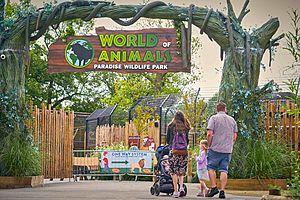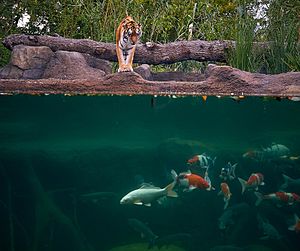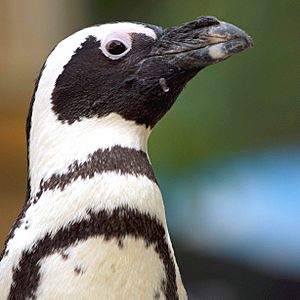Paradise Wildlife Park facts for kids
| Date opened | 1984 |
|---|---|
| Location | White Stubbs Lane Broxbourne, Herts EN10 7QA |
| Coordinates | 51°44′32″N 0°03′14″W / 51.742124°N 0.053988°W |
| Major exhibits | Land of the Tigers, Amazon & Beyond, Lion Pride lands, Sun Bear Heights, Jaguar Jungle, Penguin Falls, Farmyard, Rainforest Experience, Reptile Temple |
| Website | http://www.pwpark.com/ |
Paradise Wildlife Park is a fun, family-run animal park located in Broxbourne, Hertfordshire, England. It used to be called Broxbourne Zoo. The Sampson family took over in 1984 and renamed it Paradise Wildlife Park. In 2017, their daughter Lynn Whitnall became the CEO, continuing the family's work.
The park is also part of the Zoological Society of Hertfordshire (ZSH), a charity that works with the park. This zoo doesn't get money from the government. Since 2017, it has been named Hertfordshire's best outdoor attraction by TripAdvisor.
Paradise Wildlife Park is home to over 800 animals. You can see amazing creatures like Amur tigers, white lions, and snow leopards. There are also European wolves, African penguins, and red pandas. Other animals include Green anacondas, Two-toed sloths, lemurs, and meerkats. You can also spot Bactrian camels, Plain's zebras, and Brazilian tapirs.
The park is always growing! They plan to open new habitats for sun bears, binturongs, and Asian short-clawed otters. They are also building a special jaguar habitat. In 2020, the zoo even got its own TV show on CBBC called One Zoo Three. This show follows the daily lives of the zoo's owners.
In 2018, the park opened "World of Dinosaurs." This is an exciting adventure trail with over 30 life-sized moving dinosaurs. Besides animals, the park has an outdoor paddling pool, adventure golf, a train ride called ‘Rex Express’, and five indoor and outdoor play areas.
Contents
Explore the Animal Exhibits
Land of the Tigers
Opened in 2020, Land of the Tigers is a special exhibit. It's the first in the UK where you can view tigers underwater! This exhibit also mixes Amur Tigers with Koi and Grass Carp, which is unique.
Lion Pridelands
Lion Pridelands opened in 2019 for the park's white lions. Paradise Wildlife Park plans to focus more on conservation in the future. This means they will gradually move away from white cats over the next five years.
Rainforest Experience
This indoor exhibit is home to many small monkeys. You can see Pygmy Marmosets, Golden Headed Lion Tamarins, and Emperor Tamarins. It also houses Two-Toed Sloths and Three-Banded Armadillos.
Temple of Angkor
Built in 2004, this indoor reptile house is full of snakes and lizards. You might see Reticulated Pythons, Madagascan Day Geckos, and Barons Racers. There are also Black Breasted Leaf Turtles.
Amazon & Beyond
This new indoor exhibit features the largest Green anaconda on show in the UK! You can also find False Water Cobras, Beaded Lizards, Plica-Plica, and Piranhas here.
Penguin Falls
Penguin Falls helped launch the zoo's charity, ZSH. It also marked the start of a big 10-year plan to rebuild and improve the zoo.
History of Paradise Wildlife Park
The park first opened in the early 1960s as Broxbourne Zoo.
In 1984, the Sampson Family bought the zoo. They wanted to give the animals bigger homes that felt more like their natural habitats. The zoo closed for two years for this big change. It reopened as "Paradise Park and Woodland Zoo," which later became "Paradise Wildlife Park" in the 1990s.
Since the Sampson family took over, the team has worked hard to improve the animals' living conditions. Paradise Wildlife Park is known for its conservation efforts. They work with the Wildlife Heritage Foundation (WHF) in Kent. WHF helps with research and breeding programs for endangered species.
Throughout the 1980s, the park kept improving. They built new animal paddocks and better pathways. They also planted more trees around the park.
Park Improvements: 1990s to 2000s
In the early 1990s, the park's name officially changed to "Paradise Wildlife Park." Work continued to make the park even better. They built new, spacious enclosures, including "Tiger Lodge" in 1994 for their Bengal and Siberian tigers.
The park also improved areas for visitors. Three new adventure playgrounds were added. All parts of the park were updated. Changes were also made to make the park more accessible for people with disabilities.
Paradise Wildlife Park Today
Like many animal attractions in England, Paradise Wildlife Park had to close in 2001 due to the Foot and Mouth epidemic.
Work continued on new animal homes. Meerkats, otters, Brazilian tapirs, red pandas, and European grey wolves joined the animal family. Major new sections were created, like "Squirrel Monkey Island" and "Wonders of the Rainforest." The Animal Resource Centre (ARC) was also built. This center has a vet room, food preparation areas, and staff facilities.
The park also improved its paddocks and added more parking. They even upgraded their electricity and water systems. "The Special Place" was added too, which is a new play area designed for children with disabilities.
In 2001, the park's parent company helped create the Wildlife Heritage Foundation (WHF). WHF is a charity that supports conservation projects. It also helps with breeding programs for endangered species. Paradise Wildlife Park helps fund WHF's important work.
Amazing Animals at the Park
Paradise Wildlife Park is home to over 500 animals. These include small mammals, farm animals, birds, primates, reptiles, and big cats. You can see Siberian tigers, snow leopards, ocelots, and jaguars. They also have white lions.
The park has been very successful in breeding endangered species. This includes marmosets, tamarins, and Burmese pythons. Many animals are part of the European Endangered Species Programme (EEP). This program helps protect animals that are at risk.
Here are some of the animal areas at Paradise Wildlife Park:
- Big Cat Territory
This area is home to some of the world's most endangered big cats. You can see ocelots, white lions, snow leopards, jaguars, and Amur tigers.
- Hooves and Humps
This section houses hoofed animals. You can find endangered Bactrian camels, African plains zebras, Brazilian tapirs, and reindeer here.
- Farmyard
The zoo has many different farm animals. You can meet pygmy goats and sheep, among others.
- Tropical Rainforest
Paradise Wildlife Park has the largest collection of small monkeys in the UK. This natural rainforest house has over 10 species of small monkeys. You can also see sloths, armadillos, and other tropical creatures.
- Angkor Reptile Temple
The Angkor Reptile Temple is home to Optimus Prime, the largest Anaconda in the UK. The zoo also has over 35 different types of snakes, lizards, spiders, alligators, and insects.
- Birds & Aviary
This section features many different birds. You can see owls, eagles, and many other bird species.
- Small Mammals
This area houses a collection of smaller mammals. You can find meerkats, red pandas, otters, and wallabies here.




